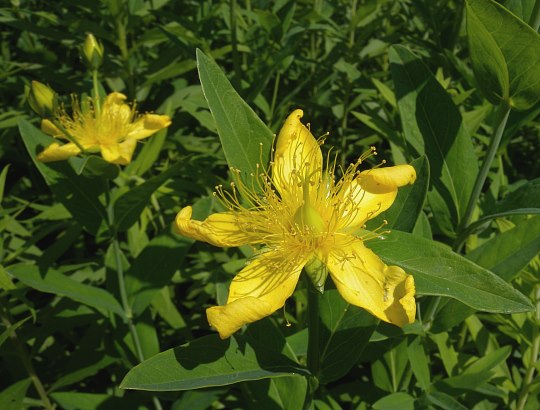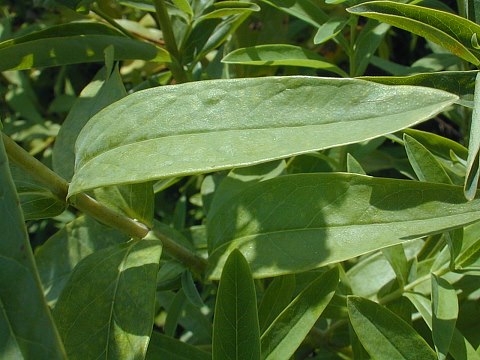Description: This herbaceous perennial wildflower is 3-5' tall. The erect stems are unbranched, except in the upper-third of each plant. Each stem is light green, glabrous, 4-angled, and slightly winged on the angles. The opposite leaves are up to 4" long and 1½" across; they are lanceolate, lanceolate-ovate, or ovate, smooth along the their margins, and glabrous. The upper surface of each leaf is medium green, while the lower surface is pale green. The leaves are sessile or they clasp the stem slightly.

The central stem
and lateral upper stems (if any) terminate in cymes of 1-5 flowers.
Relative to the size of the flowers, branches of each cyme are rather
short. Each flower is about 2" across, consisting of 5 yellow petals, 5
green sepals, numerous yellow stamens (about 100), and a light green
pistil with 5 persistent styles. The petals are widely spreading and
often rather floppy or contorted; they may develop streaks of white
with age. The sepals are lanceolate-ovate and much shorter than the
petals. The blooming period occurs during mid-summer and lasts about
2-3 weeks. Each flower is replaced by a large hairless seed capsule up
to 1¼" long and ½" across. Each seed capsule is divided into 5 cells;
each cell contains
numerous small seeds that are narrowly oblongoid,
flattened, and black at maturity. The root system is rhizomatous, often
forming small colonies of plants.
Cultivation:
The preference is full sun to light shade and moist conditions. This
wildflower adapts to different kinds of soil, including loam,
clay-loam, and rocky soil. It is robust and easy to grow.
Range & Habitat:
The native Giant St. John's Wort is occasional in northern and
west-central
Illinois; it is rare or absent elsewhere in the state. Illinois lies
along the southern range limit of this species in North America; it
also occurs in Eurasia. Habitats are rather variable, but they include
woodland openings, wooded slopes, banks of rivers and streams, moist
thickets and meadows, river-bottom prairies, and fens. This species is
usually found in high quality habitats. It is sometimes cultivated in
gardens.
Faunal Associations:
The flowers are pollinated primarily by bumblebees, which collect
pollen. Smaller bees and other insects may visit the flowers as well,
but they are less effective pollinators. Only pollen is available as a
reward to floral visitors. Some insects feed on the leaves, flowers,
and other parts of this and other Hypericum spp.
(St. John's Wort species). These include the caterpillars of the moths Eupithecia
miserulata (Common Pug), Melanchra assimilis
(Black Arches), Synchlora aerata (Wavy-Lined
Emerald), Hyppa xylinodes (Common Hyppa), Nedra
ramosula (Gray Half-Spot), and Agonopterix hyperella
(Oecophorid Moth sp.). The caterpillars of the butterfly Strymon
melinus (Gray Hairstreak) feed on the developing capsules and
seeds. Other insects that feed on Hypericum spp.
include the aphid Brachysiphum hyperici, and the
leaf beetles Pachybrachis relictus and Paria
sellata. The foliage is somewhat toxic to mammalian
herbivores and usually avoided because it can cause irritation of the
gastrointestinal tract. The foliage can also cause a harmful reaction
to sunlight in light-skinned animals (e.g., pigs), causing irritation
of the skin.
Photographic Location:
A restored prairie at Meadowbrook Park in Urbana, Illinois.

Comments: This species has large attractive flowers and foliage. Unfortunately, the blooming period is relatively short. Giant St. John's Wort is easy to identify because of its large size and the presence of 5 styles on its flowers and seed capsules. Other large Hypericum spp. are usually woody, rather than herbaceous, and they usually have only 1-3 styles. An exception is the woody Hypericum kalmianum (Kalm's St. John's Wort), which also has 5 styles. This latter species has smaller flowers, more narrow leaves, and a shorter and more branched habit of growth than Giant St. John's Wort. Some taxonomists consider North American populations of Giant St. John's Wort to be distinct from the Eurasian populations, and refer to this species as Hypericum pyramidatum. Another common name of this species is Great St. John's Wort.